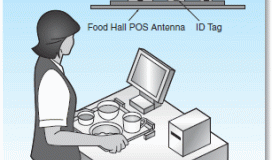Radio-frequency identification (RFID) is a step forward technology used for identifying a subject with the help of radio signals. It is most likely used for inventory control or for timing sports events. This technology is a complement for distant reading of barcodes. It can be used for the identification of a person, an item or any package. For utilizing this technology in the most efficient way, RFID tags are used. RFID tags have at least two parts; one is an integrated circuit for storage and processing of information by modulation and de-modulation of RF signals. The second part of a RFID tags is an antenna to receive and transmit the signal. Usually, these tags are of 2 types: a passive tag, with no battery, and active tags, which has a battery. RFID tags can be embedded into an animal, a product or a person for tracking and identification needs, using radio waves.
RFID tags are widely and effectively used in farm management and electronic identification of animals; precisely cattle identification. There has been an increase in the need for improvement in the ongoing production and management methods and use of electronic identification (EID)/ RFID cattle tags is efficiently meeting those needs. These tags are small button structured tags, which are attached to the animal’s ear each of the tag has a unique number of 15 digits.
The number can be read by scanning a tag with an RFID reader. These tags can be used very efficiently, and it is designed to last for the complete life of animal. By implanting a RFID microchip in pets and livestock, you can avail yourself with positive identification of animals.
Cattle electronic identification has both visual and management advantages. By equipping your each cattle with cattle ear tags, you can more easily differentiate between them and can store essential data pertaining to that particular animal in the tag. It also helps you in tracking animal's growth, developmental performance and health. Visual tags might get lost, but RFID tags are compact and implanted in a distinguished manner. Scanning can be done using an EID tag reader; it saves time and also minimizes the risk of errors.
RFID animal tags smoothens the farm management in the most graceful manner. RFID technology facilitates farmers in rounding up the livestock in a more efficient manner, provide and manage their food/water etc. It can also help to manage livestock's health monitoring. For farm management, animal tags can suffice purposes such as, meat safety, market access, and bio-security and product integrity as well.



